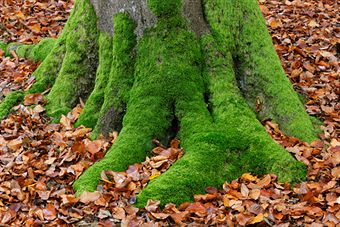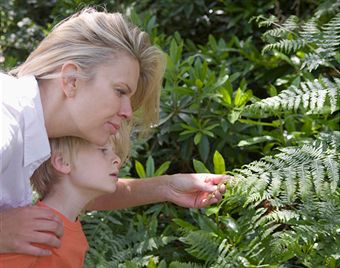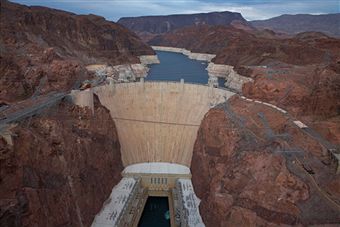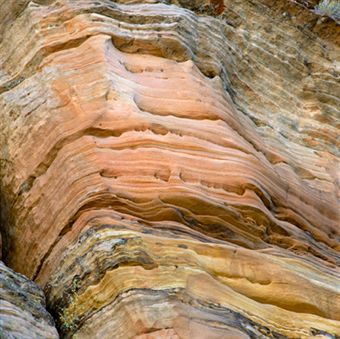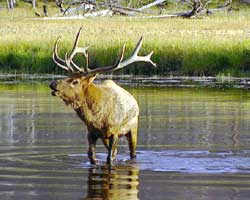جنگل های بارانی آمریکای شمالی
فایل داستانهای آموزشی زبان انگلیسی
North America’s Rainforest
When people think of rainforests, they usually think of the tropical jungle. But heavy rain can also produce dense forests in temperate areas. Along the northwest coast of North America, there are some of the largest trees in the world. This forest runs along the Pacific Coast from Alaska down to northern California. About half of it is in British Columbia, Canada. Several species of trees grow to an immense size. Some grow up to 95 metres (312 feet) high, and 12 metres (40 feet) in circumference. They may be as much as 1,000 years old. Because the trees are so tall, the forest has various levels of growth. Small plants attach themselves to the tall trees and may form a kind of garden in the air. Further down are the tops of the younger trees. Closer to the ground are shrubs and bushes. Along the ground are moss, ferns, berries and other plants. These old forests have developed over several thousand years. The tall trees are at least several hundred years old. This old forest has several special features. Some of the dead tall trees remain standing and become homes for insects, birds and small animals. Trees that fall to the ground can become “nurse logs” for new plants or trees to grow on. Trees that fall across rivers and streams can provide natural dams, which provide quiet water for animals to live in. In recent years, it has become common for logging companies to “clear-cut” this old forest. To clear-cut a forest means to go into a section of forest with heavy machinery and cut down every tree. Sometimes, these “clear-cuts” are as large as some European countries. Logging companies are doing this because it is a cheap method of logging. The problem is that when an old forest is cut, it does not grow back again. Even with replanting, companies produce a tree farm, not an old forest. The complexity of an old forest, which grew over thousands of years, is lost forever. The old forest can shelter many kinds of birds, mammals, fish and plants that a replanted forest cannot. Another issue is that companies are cutting more and more old forests because they haven’t done enough replanting. As long as governments have been willing to let companies cut old forests, neither logging companies nor governments have been much motivated to replant the forests. As a result, most of the old forest has been cut down and continues to be cut at a rapid rate. This situation has also worsened because new technology allows more rapid logging. Clear-cut logging results in erosion, which, in turn, damages the quality of rivers and streams. This causes a decline in the salmon fishery. Animals like grizzly bears, elk and deer are harmed by the loss of habitat. Likewise, birds that nest in the old forest, such as bald eagles, owls, woodpeckers and various seabirds are being threatened. Recently, public interest in the old rainforests has resulted in an increase in tourism. People come to see these spectacular trees and the many plants and animals that depend on them. We hope that these unique temperate rainforests will remain for many more generations to enjoy.
Circumference
A line that goes around a circle or any other curved shape; the length of this line
The circumference of the earth
The earth is almost 25000 miles in circumference.
Shrub
A large plant that is smaller than a tree and that has several stems of wood coming from the ground; bush
Evergreen shrubs
Shrub roses
Moss
A very small green or yellow plant without flowers that spreads over damp surfaces, rocks, trees, etc
Moss-covered walls
Fern
A plant with large delicate leaves and no flowers that grows in wet areas or is grown in a pot. There are many types of fern.
Dam
A barrier that is built across a river in order to stop the water from flowing, used especially to make a reservoir (= a lake for storing water) or to produce electricity
The Narmada dam in India
The dam burst.
Erosion
Source 1
erode
1 to gradually destroy the surface of something through the action of wind, rain, etc; to be gradually destroyed in this way; wear away
Erode something (away) The cliff face has been steadily eroded by the sea.
Erode (away) The rocks have eroded away over time.
2 erode (something) to gradually destroy something or make it weaker over a period of time; to be destroyed or made weaker in this way
Her confidence has been slowly eroded by repeated failures.
Mortgage payments have been eroded (= decreased in value) by inflation.
Erosion
The erosion of the coastline by the sea
Soil erosion
The erosion of her confidence
Source 2
1 the process by which rock or soil is gradually destroyed by wind, rain, or the sea:
The problem of soil erosion
The erosion of the coastline
2 the process by which something is gradually reduced or destroyed
Erosion ofThe gradual erosion of our civil liberties
Source 3
1 a: the action or process of eroding
b: the state of being eroded
2: an instance or product of erosion
Examples of EROSION Landscapers planted grass to stop the erosion of the hillside.
Centuries of erosion by wind have carved grooves in the rocks.
Synonyms: attrition, corrosion, undermining, waste
Antonyms: buildup
Grizzly bear
A large aggressive brown bear that lives in N America and parts of Russia
elk



